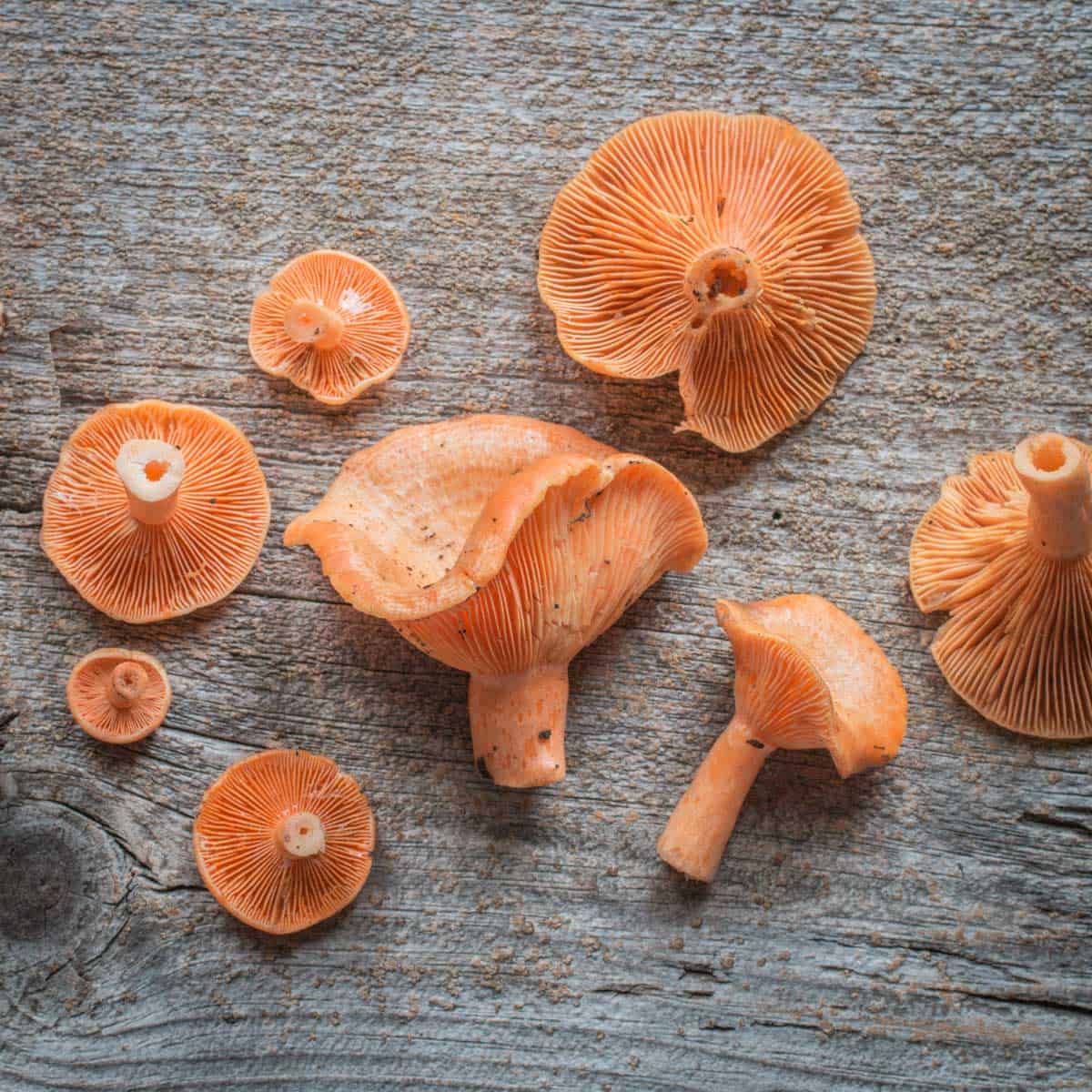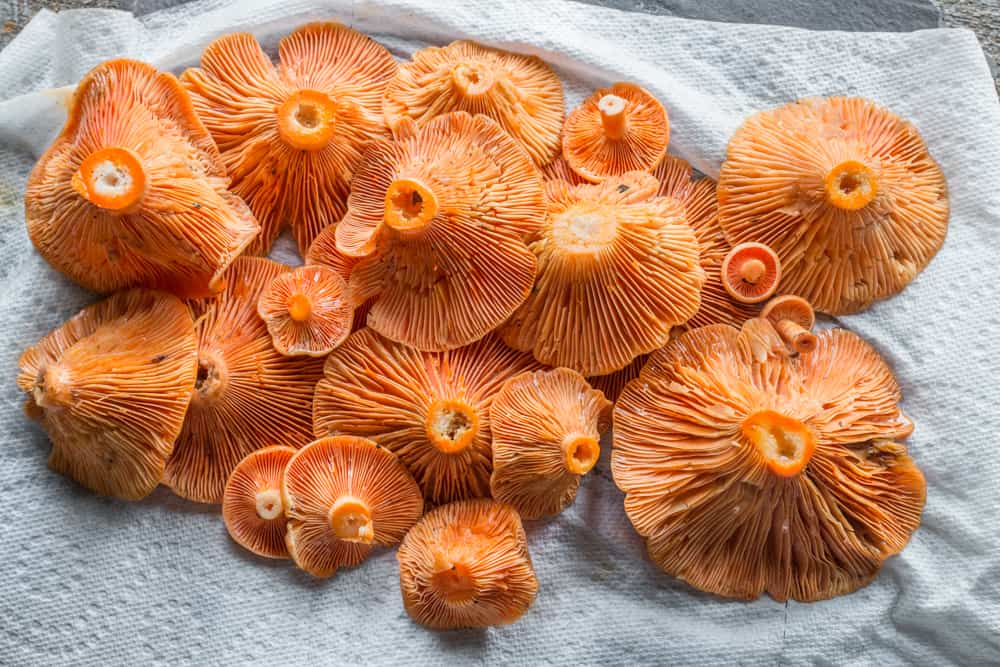One of the best parts of modern mushroom hunting is the amount of information that gets shared on a daily basis. Tons of information and observations are shared daily, and depending on how many groups and regions you pay attention to, there's a lot you can glean without having to leave your home.

A great example for me in 2018 was when my friend Pete posted to one of our local forums about a Lactarius he'd picked earlier this year using a name I hadn't heard before: thyinos.
I like Saffron milk caps, but the patches I pick near the Twin Cities proper with red and eastern white pine are picky about when they'd like to fruit, and when they do come up, it can be invisible.
The mushrooms can be buried completely under inches of needle duff, with mushrumps (bumps in the forest floor indicating mushrooms) so imperceptible they may as not even exist. As big a fan in exercises in futility that I am, I prefer my mushrooms visible, clean, and not buried under needles.

Habitat
I kept striking out at my pine patches around St. Paul, but, traveling up north I found an easier way to grab bags full of the deliciosus group: change terrain. Instead of hitting patches of pine woods inside of larger deciduous forest, I just drove a couple hours north into the taiga, where conifers rule and oaks are the rarity.

(Michael Kuo says they're well known in cedar bogs) A number of places with aspen, birch and cedar where I hunt Leccinum and chanterelles were bursting with bright orange mushrooms, and I was thrilled when I picked a few up and noticed that they didn't stain green when bruised or touched, at all.

Typical Saffron milkcaps, Lactarius deliciousus are ok to eat. They're not going to exactly blow your mind, but they make up for it with the shock of seeing brilliant orange mushrooms popping up through the pine needles.
I'd I see deliciosus, I'm probably going to pick them. The biggest draw back with L. deliciosus is visual: (along with the typical bug damage you might see with Lactarius in the Midwest) the mushrooms stain a dingy green when bruised, and although it doesn't affect the flavor, it's definitely unappealing.
After tromping around in the woods in your bag or backpack, that haul of brilliant orange mushrooms can arrive in your kitchen a bruised green mess, depending on how much they were jostled in transportation. Sometimes to preserve colors of mushrooms that bruise, I'll carry paper towels or wax paper with to wrap delicate mushrooms individually.

Cooking
Before I even cooked them, the absence of green bruising alone shot these to the top of the Deliciosus group for me. After I ate a few I was even more impressed, they cooked up like a dream, and the flavor was great.
Typical saffron milkcaps get a bad rap for being crumbly or grainy tasting, the thyinos were better on all counts for me. The structure of the mushrooms is noticeably lighter, more delicate than other saffron milk caps. The lighter structure and overall delicate-ness seemed to translated to a better eating experience, but that might just be the mangalitsa lard talking.
Either way, these are super easy to mushrooms from the delciosus group, and good eaters. Keep your eyes open for them.
Recipes
You can obviously sub these for saffron milk caps in any recipe. As I've mentioned before, Spain's love for these mushrooms, that they'll call rovellones or niscalos) is unparalleled, so they have a number of preparations that call for them specifically.
My favorites so far being fricando (dish of braised veal) and Catalan saffron milk caps (cooked with sausage).
Fricando of veal with saffron milkcaps
Catalan saffron milkcaps
Saffron milkcaps with chickpeas and Gran Queso
Saffron milkcap paella
Fried saffron milkcaps with yogurt
Conserve (I like to blanch saffron milkcaps should before preserving to remove mucilage)

Lorna Koestner
Hello Alan, I love your blog and website. You have confirmed that I have a Lactarius deliciosus..and it doesn't bruise green .. is the thyinos a variety of L deliciosus, or is it considered a separate species?
Alan Bergo
It is a saffron milkcap, there's a number of them, it isn't only L. deliciosus as that's probably a European species.
Maria S
I was just shown these today for the first time by a relative! What gorgeous mushrooms. But we've had so much rain (SW Ontario, Canada) that they are very dirty. i tried brushing and swishing in water and they are still quite gritty.
Any tips?
Alan Bergo
That can happen. Sometimes the conditions are just not ideal for picking. You can blanch them in boiling water which can help, but you'll lose some flavor.
Jeanne
I am in Southeast Minnesota and I think I found lactarius thyinos on a deadfall tree in my backyard today. The orangish peach colored cap are gills are very distinctive and the smell is pleasant. Strangely enough, this is the third species of mushrooms this long dead elm has produced since I moved here last year.
Alan Bergo
Jeanne, typically I need to see images to give you an ID, but I can tell you for a couple reasons that what you have isn't L. thyinos. Lactarii never grow from trees, for starters, and they won't start fruiting until July. Hope that helps.
Sarah
I have found them under spruce, white pine and fir trees? It's saying online they grow in cedar bogs? Can they grow outside of that area? Mine check out and look just like your photos. I want to eat them but the location is what is stopping me. Love your site! Thanks!
Alan Bergo
I think you probably have something in the deliciosus group, whether it is them or not IDK as near identical ones will fruit at the same time. Everything in the deliciosus group is edible to my knowledge.
Viola
Thanks for your website! It's invaluable to me in what is possible for me to find even farther north here in Northwestern Ontario Canada. And LOVE your recipes!
Viola
I've been passing this one by for years because I knew it was a milkcap, but not the orange with green deliciousus. So I just didn't know. Now I know. And this is a truly lovely tasty mushroom. And a beaut on the plate.
I always find this one when lobster mushroom hunting, so I'll be doubling up on the orange mushrooms from now on.
Alan Bergo
You'll lovem. My favorite of the deliciosus group.
pete hautman
One of my favorites. They are abundant in the arrowhead region, where I vacation in August, most years. They seem to show up even in dry conditions, and are rarely buggy.
Alan Bergo
I have you to thank for sharing priming me to be on the lookout for them. Thanks.